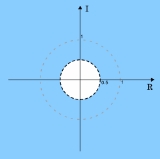
Z-transform
Overview
Mathematics
Mathematics is the study of quantity, space, structure, and change. Mathematicians seek out patterns and formulate new conjectures. Mathematicians resolve the truth or falsity of conjectures by mathematical proofs, which are arguments sufficient to convince other mathematicians of their validity...
and signal processing
Signal processing
Signal processing is an area of systems engineering, electrical engineering and applied mathematics that deals with operations on or analysis of signals, in either discrete or continuous time...
, the Z-transform converts a discrete
Discrete mathematics
Discrete mathematics is the study of mathematical structures that are fundamentally discrete rather than continuous. In contrast to real numbers that have the property of varying "smoothly", the objects studied in discrete mathematics – such as integers, graphs, and statements in logic – do not...
time-domain signal, which is a sequence
Sequence
In mathematics, a sequence is an ordered list of objects . Like a set, it contains members , and the number of terms is called the length of the sequence. Unlike a set, order matters, and exactly the same elements can appear multiple times at different positions in the sequence...
of real
Real number
In mathematics, a real number is a value that represents a quantity along a continuum, such as -5 , 4/3 , 8.6 , √2 and π...
or complex number
Complex number
A complex number is a number consisting of a real part and an imaginary part. Complex numbers extend the idea of the one-dimensional number line to the two-dimensional complex plane by using the number line for the real part and adding a vertical axis to plot the imaginary part...
s, into a complex frequency-domain representation.
It can be considered as a discrete-time equivalent of the Laplace transform. This similarity is explored in the theory of time scale calculus
Time scale calculus
In mathematics, time-scale calculus is a unification of the theory of difference equations with that of differential equations, unifying integral and differential calculus with the calculus of finite differences, offering a formalism for studying hybrid discrete–continuous dynamical systems...
.
The basic idea now known as the Z-transform was known to Laplace, and re-introduced in 1947 by W. Hurewicz
Witold Hurewicz
Witold Hurewicz was a Polish mathematician.- Early life and education :Witold Hurewicz was born to a Jewish family in Łódź, Russian Empire ....
as a tractable way to solve linear, constant-coefficient difference equations.
It was later dubbed "the z-transform" by Ragazzini
John R. Ragazzini
John Ralph Ragazzini was an American electrical engineer and a professor of Electrical Engineering. Ragazzini was born in New York and received the degrees of B.S. and E.E. at the City College of New York in 1932 and 1933 and earned the degrees of A.M. and Ph.D...
and Zadeh in the sampled-data control group at Columbia University in 1952.
The modified or advanced Z-transform
Advanced Z-transform
In mathematics and signal processing, the advanced Z-transform is an extension of the Z-transform, to incorporate ideal delays that are not multiples of the sampling time...
was later developed and popularized by E.
Unanswered Questions

